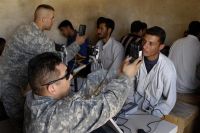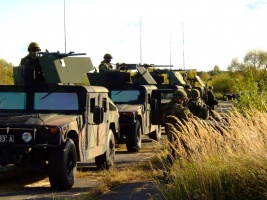WASHINGTON — Considered a battlefield curiosity just a few years ago, biometrics has become recognized as a vital warfighting capability. Now, defense officials see the same technology as a key to helping the Defense Department make its business practices more efficient.
Biometrics – the science of using unique physical and behavioral characteristics to identify a person – has proven to be invaluable to the warfighter’s toolbox, Myra S. Gray, director of the Army’s Biometrics Identity Management Agency, told American Forces Press Service.
“Five years ago, it was something very new, and the capability wasn’t fully understood. It was kind of an add-on to the mission,” she said. “Now it’s an integral part of the mission because people have seen the value that it brings.”
Gray’s office, known as the Biometrics Task Force until it was redesignated in March, is responsible for capitalizing on biometrics technology and promoting new advances to benefit the entire Defense Department.
Fingerprints and other personally identifying features such as a person’s distinct iris, facial, palm and voice features have become particularly helpful in the intelligence and law enforcement arenas, she said.
They help combat troops tell friends from foes and identify potential terrorists before it’s too late. They also provide a foolproof way to put names and faces to insurgent activities and to identify released detainees who have returned to terrorist activity.
“You can identify an individual and associate him with certain actions,” Gray said. “You can figure out who someone associated with and what they have been involved in. You can link events such as an [improvised explosive device] at one place and a protest at another. You build a picture of what has gone on.”
Meanwhile, biometrics has become a vital tool in vetting people in the combat zone before they’re granted access “inside the wire,” or into secure or sensitive facilities. “We want to make sure that the people we permit onto our facilities are not the same people putting IEDs down,” Gray explained.
Biometrics also is widely employed beyond the combat zone to control access to military facilities worldwide. For example, every military member, family member and Defense Department civilian employee has a common access identification card that’s embedded with their fingerprints.
But other biometric technologies are in wide use throughout the military. At Eglin Air Force Base, Fla., for example, the Air Force uses a device that “reads” hand prints to clear veterans receiving treatment at the Veterans Affairs clinic for access to the base hospital. At Fort Belvoir, Va., the Army uses iris scanning technology to provide keyless entry to sensitive areas. And the Navy regularly uses biometrics equipment to confirm identifies as they board foreign vessels.
Gray anticipates broader use of this capability military-wide, particularly as the technology becomes increasingly faster, higher-quality and less obtrusive.
Among the more promising technologies the Defense Department is exploring are biometric systems able to scan people “on the move” without requiring them to touch anything or even stop. Commercial airports see this as a great way to eliminate long back-up lines at security checkpoints.
But Gray also recognizes warfighting applications, particularly at border crossings and other ports of entry where there’s a mass movement of people and insurgents might try to blend in undetected.
“Those same ports of entry that legitimate business people or family members are crossing are the same places that the insurgents come across,” she said. “By having this technology, you will have the ability to ferret out those who are hiding amongst the populace without negatively impacting the population.”
Meanwhile, Gray anticipates broader use of biometrics off the battlefield, particularly as the department acts on Defense Secretary Robert M. Gates’ mandate to improve efficiency.
“The next big step forward in biometrics is definitely going to be in the business process arena,” she said. “It is truly a cross-cutting capability” she said can be applied in “a whole spectrum of functions, from the medical field to personnel to financial fields.”
Biometrics can go a long way in streamlining recordkeeping, improving information-sharing and cutting out fraud – not only for the Defense Department, but for the U.S. government as a whole, she said.
“We have a lot of benefits and a lot of services in which we rely on identifying someone so we can properly provide them what they need,” Gray explained.
She cited just a few ways biometrics would improve the inter-department sharing that supports those benefits and services. Biometrics could help the Defense Department share military medical records with the VA, civilian employee records with the Office of Personnel Management and employee benefit records with the Social Security Administration.
“The big question is, ‘How do we pull that thread of identity to make sure we are more efficient as the U.S. government in providing services?’ ” Gray said. “By integrating that across the U.S. government, we can find great efficiency.”
Underlying this effort, she emphasized, is “a complete and total focus on privacy” that ensures all personally identifying information is protected in accordance with the Privacy Act.
“This is one of the foundations as we build this system,” Gray said. “We are building these systems with a strong focus on making sure we are within the guidelines of the law and policy in protecting that information. That is paramount. We can’t compromise on that.”
Source:
U.S. Department of Defense
Office of the Assistant Secretary of Defense (Public Affairs)

 von
von 
